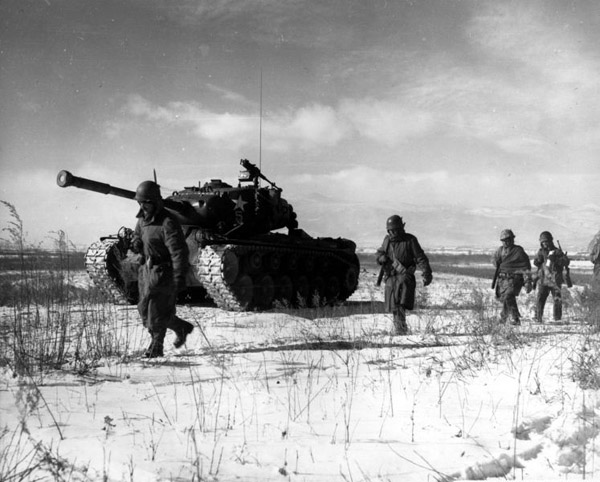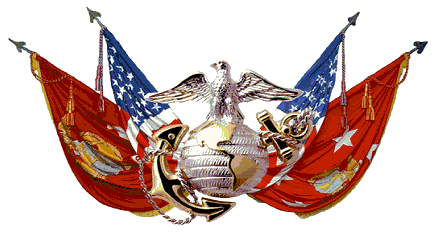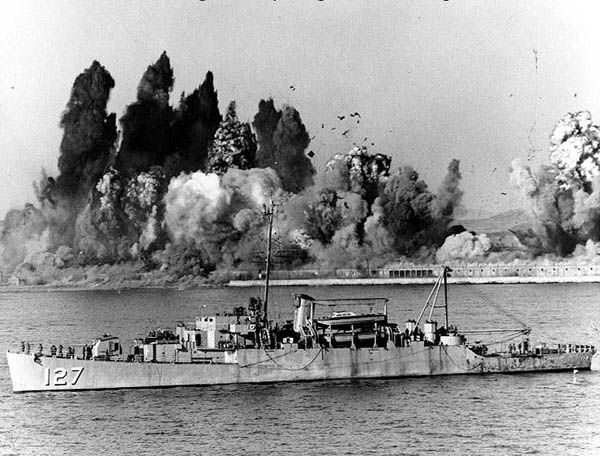US MARINES AT CHOSIN RESERVOIR
Marines devastated by over 100,000 Chinese troops - Page 3
BLOODY CHOSIN RESERVOIR
On Thanksgiving day, 1950, the American push North was going well. The rumors about the Chinese entering the war persisted. After all, MacArthur had said “don’t worry about the Chinese, all of our troops will be home by Christmas.” These pathetic words were to go down in history. A few days later, with heavy snow and sub-zero temperatures, the Marines were attacked by Divisions of Chinese soldiers Divisions that MacArthur said not to worry about. Over 120,000 Chinese stormed across the Yalu and struck the most decisive blow of the war. Screaming and blowing bugles they swarmed the smaller Marine units, endangering the lives of those around the Chosin Reservoir. Of our 25,000 troops who faced the 120,000 Chinese at Chosin, at least 6,000 were killed, wounded, or captured, and at least another 6,000 suffered severe frostbite. On the reservoir’s east coast a full Chinese Division attacked a unit of less than 3,000 men, who had no reinforcements. The Chinese killed the entire unit which had 1053 Officers. Today the remains of the unknown men who fell there still lie unmarked in the barren wasteland.

CHOSIN RETREAT (MAP)
The Chinese paid a terrible price for their victory. Marine records show 25,000 Chinese killed and 12,500 wounded. Thousands of Marines had only one way out, and that was to retreat from the Reservoir to Hamhung. Chinese soldiers studded the mountains with rifles slung on their shoulders, packs on their backs, covered in snow, frozen to death.

1st MARINE DIVISION MOVES THROUGH CHINESE LINES
The only solution for the Marines was a hasty retreat from Chosin to Hamhung, a seemingly impossible task considering the bloody attacks by the Chinese. The battles of the Chosin campaign, which had a decisive impact on the future course of the war, were fought in the ten day period between Nov. 27 and Dec. 6, 1950. Three major actions were fought; the successful defense of Hagaru-ri, the successful defense of Yudam-ni, the successful effort of the 5th and7th Marines to break through from Yudam-ni to Hagaru-ri.
When the 1st Marine Division and elements of the 7th Infantry Division found themselves completely surrounded by the 9th Army Group of the Peoples Liberation Army, MacArthur ordered the Marines to fight their way out of the trap. The Chinese had launched heavy assaults that had halted the UN offensive. The planned retreat to Hungnam was an extremely perilous undertaking. Col. Chesty Puller’s 1st Marine Regiment had been at Koto-ri when the Chinese launched their attack. Puller was ordered to open up the road to where the majority of the Division was. Puller’s Task Force only made it half way to the objective due to stiff enemy resistance. The Chinese ambushed Puller’s Task Force and cut it to pieces. The Task Force became bogged down, separated, with no radio contact. Later that evening Lt. Col. Drysdale, who was wounded, appeared to beef up the trapped Task Force. His unit of roughly 400 men was stranded and surrounded by Chinese forces. Most of the unit was wiped out, killed, wounded, or taken prisoner. Only a few made it back to Koto-ri. 300 men of Drysdale’s unit were killed, 135 taken prisoner. The Chinese also destroyed 75 of the 141 vehicles.

US TROOPS LOADED IN SHIPS AT HAMHUNG
During the entire withdrawal Marines were under furious attack. The sub-zero temperature caused more casualties than the Chinese ( who also suffered greatly from the extreme cold.) Over 4,000 wounded were flown out during the operation. Marines and soldiers were able to disable a substantial amount of the Chinese Divisions that blocked their escape from the reservoir. In the midst of the defeat, the strategic situation was highly unfavorable for UN forces, and it was decided to withdraw the entire X Corps from North Korea. The Marines and the remainder of the X Corps forces, and thousands of civilians and refugees headed for the Port of Hamhung, which would be destroyed to deny it’s use to the enemy. Altogether 193 shiploads of men and materials were evacuated from Hungnam Harbor, and 105,000 soldiers, 98,000 civilians, 17,500 vehicles, and 350,000 tons of supplies were loaded onto the massive armada of ships and shipped south to Pusan.

FLAGS USMC

USS BEGOR STANDS OFFSHORE AS DEMOLITION CHARGES
DESTROY HUNGNAM PORT